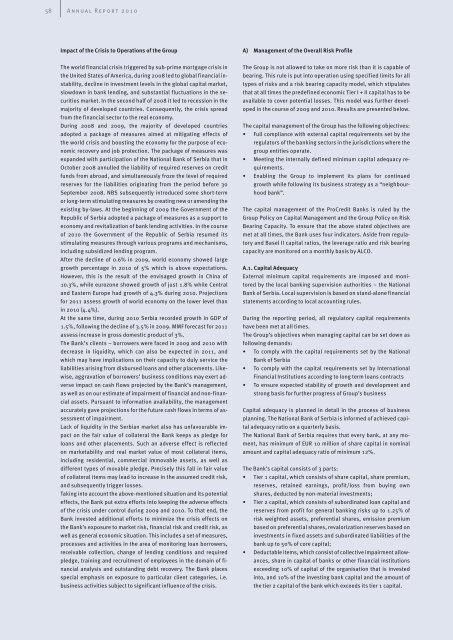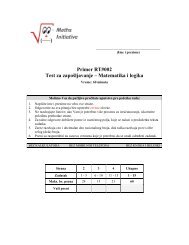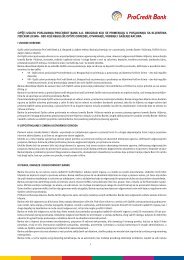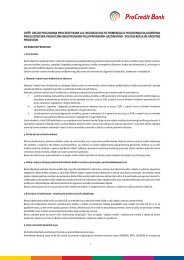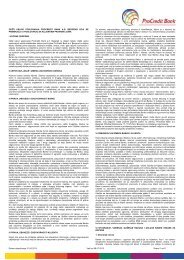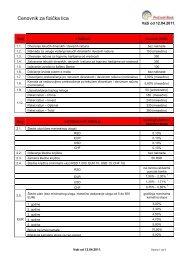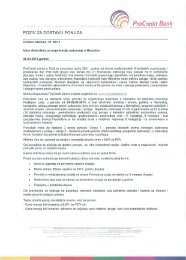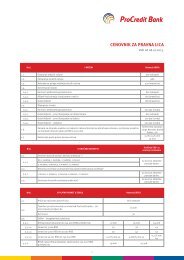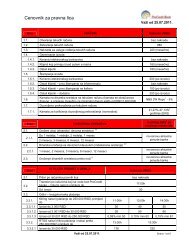Annual Report 2010 - ProCredit Bank
Annual Report 2010 - ProCredit Bank
Annual Report 2010 - ProCredit Bank
- No tags were found...
You also want an ePaper? Increase the reach of your titles
YUMPU automatically turns print PDFs into web optimized ePapers that Google loves.
58<br />
<strong>Annual</strong> <strong>Report</strong> <strong>2010</strong><br />
Impact of the Crisis to Operations of the Group<br />
A) Management of the Overall Risk Profile<br />
The world financial crisis triggered by sub-prime mortgage crisis in<br />
the United States of America, during 2008 led to global financial instability,<br />
decline in investment levels in the global capital market,<br />
slowdown in bank lending, and substantial fluctuations in the securities<br />
market. In the second half of 2008 it led to recession in the<br />
majority of developed countries. Consequently, the crisis spread<br />
from the financial sector to the real economy.<br />
During 2008 and 2009, the majority of developed countries<br />
adopted a package of measures aimed at mitigating effects of<br />
the world crisis and boosting the economy for the purpose of economic<br />
recovery and job protection. The package of measures was<br />
expanded with participation of the National <strong>Bank</strong> of Serbia that in<br />
October 2008 annulled the liability of required reserves on credit<br />
funds from abroad, and simultaneously froze the level of required<br />
reserves for the liabilities originating from the period before 30<br />
September 2008. NBS subsequently introduced some short-term<br />
or long-term stimulating measures by creating new or amending the<br />
existing by-laws. At the beginning of 2009 the Government of the<br />
Republic of Serbia adopted a package of measures as a support to<br />
economy and revitalization of bank lending activities. In the course<br />
of <strong>2010</strong> the Government of the Republic of Serbia resumed its<br />
stimulating measures through various programs and mechanisms,<br />
including subsidized lending program.<br />
After the decline of 0.6% in 2009, world economy showed large<br />
growth percentage in <strong>2010</strong> of 5% which is above expectations.<br />
However, this is the result of the envisaged growth in China of<br />
10.3%, while eurozone showed growth of just 1.8% while Central<br />
and Eastern Europe had growth of 4.3% during <strong>2010</strong>. Projections<br />
for 2011 assess growth of world economy on the lower level than<br />
in <strong>2010</strong> (4.4%).<br />
At the same time, during <strong>2010</strong> Serbia recorded growth in GDP of<br />
1.5%, following the decline of 3.5% in 2009. MMF forecast for 2011<br />
assess increase in gross domestic product of 3%.<br />
The <strong>Bank</strong>’s clients – borrowers were faced in 2009 and <strong>2010</strong> with<br />
decrease in liquidity, which can also be expected in 2011, and<br />
which may have implications on their capacity to duly service the<br />
liabilities arising from disbursed loans and other placements. Likewise,<br />
aggravation of borrowers’ business conditions may exert adverse<br />
impact on cash flows projected by the <strong>Bank</strong>’s management,<br />
as well as on our estimate of impairment of financial and non-financial<br />
assets. Pursuant to information availability, the management<br />
accurately gave projections for the future cash flows in terms of assessment<br />
of impairment.<br />
Lack of liquidity in the Serbian market also has unfavourable impact<br />
on the fair value of collateral the <strong>Bank</strong> keeps as pledge for<br />
loans and other placements. Such an adverse effect is reflected<br />
on marketability and real market value of most collateral items,<br />
including residential, commercial immovable assets, as well as<br />
different types of movable pledge. Precisely this fall in fair value<br />
of collateral items may lead to increase in the assumed credit risk,<br />
and subsequently trigger losses.<br />
Taking into account the above-mentioned situation and its potential<br />
effects, the <strong>Bank</strong> put extra efforts into keeping the adverse effects<br />
of the crisis under control during 2009 and <strong>2010</strong>. To that end, the<br />
<strong>Bank</strong> invested additional efforts to minimize the crisis effects on<br />
the <strong>Bank</strong>’s exposure to market risk, financial risk and credit risk, as<br />
well as general economic situation. This includes a set of measures,<br />
processes and activities in the area of monitoring loan borrowers,<br />
receivable collection, change of lending conditions and required<br />
pledge, training and recruitment of employees in the domain of financial<br />
analysis and outstanding debt recovery. The <strong>Bank</strong> places<br />
special emphasis on exposure to particular client categories, i.e.<br />
business activities subject to significant influence of the crisis.<br />
The Group is not allowed to take on more risk than it is capable of<br />
bearing. This rule is put into operation using specified limits for all<br />
types of risks and a risk bearing capacity model, which stipulates<br />
that at all times the predefined economic Tier I + II capital has to be<br />
available to cover potential losses. This model was further developed<br />
in the course of 2009 and <strong>2010</strong>. Results are presented below.<br />
The capital management of the Group has the following objectives:<br />
• Full compliance with external capital requirements set by the<br />
regulators of the banking sectors in the jurisdictions where the<br />
group entities operate.<br />
• Meeting the internally defined minimum capital adequacy requirements.<br />
• Enabling the Group to implement its plans for continued<br />
growth while following its business strategy as a “neighbourhood<br />
bank”.<br />
The capital management of the <strong>ProCredit</strong> <strong>Bank</strong>s is ruled by the<br />
Group Policy on Capital Management and the Group Policy on Risk<br />
Bearing Capacity. To ensure that the above stated objectives are<br />
met at all times, the <strong>Bank</strong> uses four indicators. Aside from regulatory<br />
and Basel II capital ratios, the leverage ratio and risk bearing<br />
capacity are monitored on a monthly basis by ALCO.<br />
A.1. Capital Adequacy<br />
External minimum capital requirements are imposed and monitored<br />
by the local banking supervision authorities – the National<br />
<strong>Bank</strong> of Serbia. Local supervision is based on stand-alone financial<br />
statements according to local accounting rules.<br />
During the reporting period, all regulatory capital requirements<br />
have been met at all times.<br />
The Group’s objectives when managing capital can be set down as<br />
following demands:<br />
• To comply with the capital requirements set by the National<br />
<strong>Bank</strong> of Serbia<br />
• To comply with the capital requirements set by International<br />
Financial Institutions according to long term loans contracts<br />
• To ensure expected stability of growth and development and<br />
strong basis for further progress of Group’s business<br />
Capital adequacy is planned in detail in the process of business<br />
planning. The National <strong>Bank</strong> of Serbia is informed of achieved capital<br />
adequacy ratio on a quarterly basis.<br />
The National <strong>Bank</strong> of Serbia requires that every bank, at any moment,<br />
has minimum of EUR 10 million of share capital in nominal<br />
amount and capital adequacy ratio of minimum 12%.<br />
The <strong>Bank</strong>’s capital consists of 3 parts:<br />
• Tier 1 capital, which consists of share capital, share premium,<br />
reserves, retained earnings, profit/loss from buying own<br />
shares, deducted by non-material investments;<br />
• Tier 2 capital, which consists of subordinated loan capital and<br />
reserves from profit for general banking risks up to 1.25% of<br />
risk weighted assets, preferential shares, emission premium<br />
based on preferential shares, revalorization reserves based on<br />
investments in fixed assets and subordinated liabilities of the<br />
bank up to 50% of core capital;<br />
• Deductable items, which consist of collective impairment allowances,<br />
share in capital of banks or other financial institutions<br />
exceeding 10% of capital of the organisation that is invested<br />
into, and 10% of the investing bank capital and the amount of<br />
the tier 2 capital of the bank which exceeds its tier 1 capital.


